
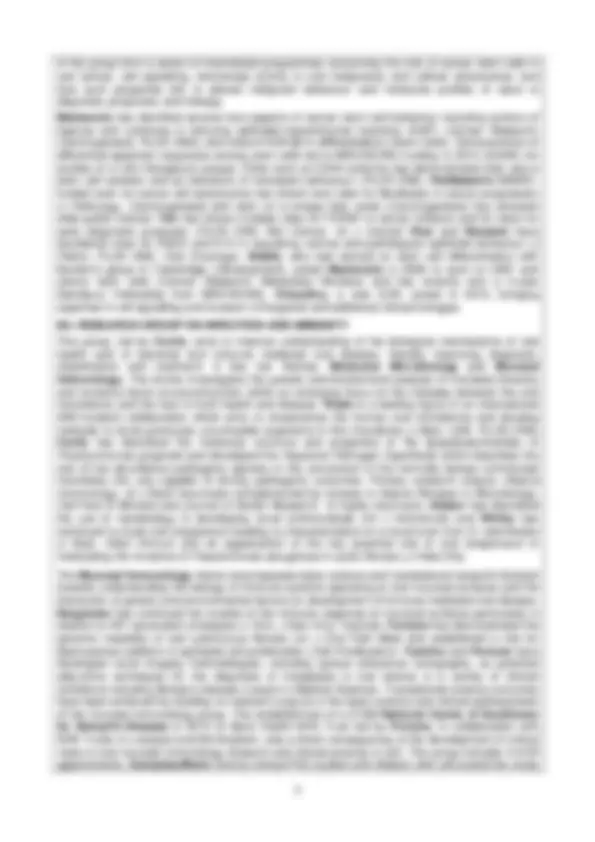
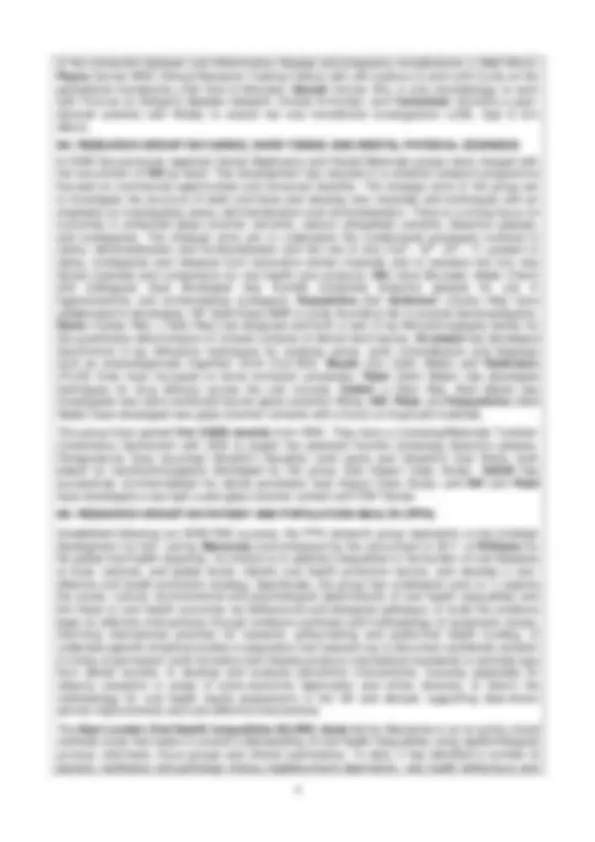
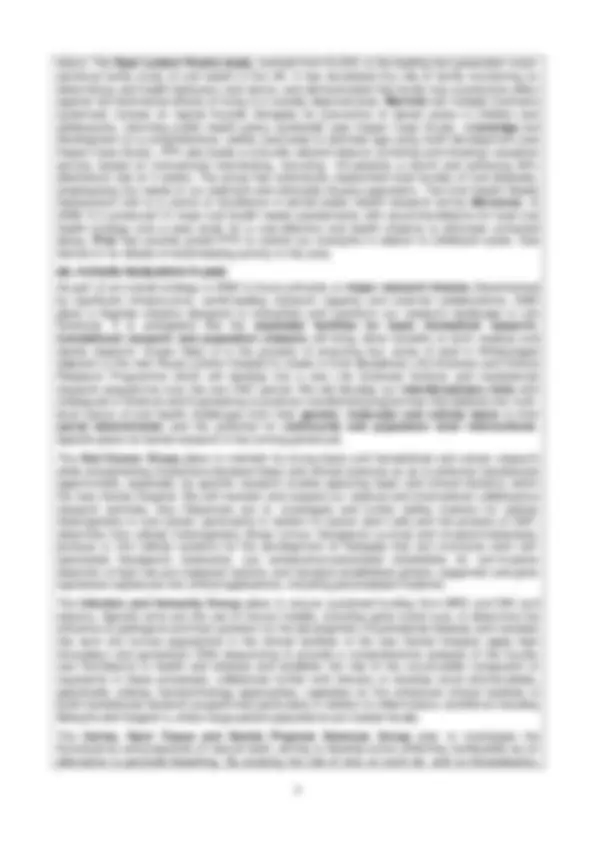
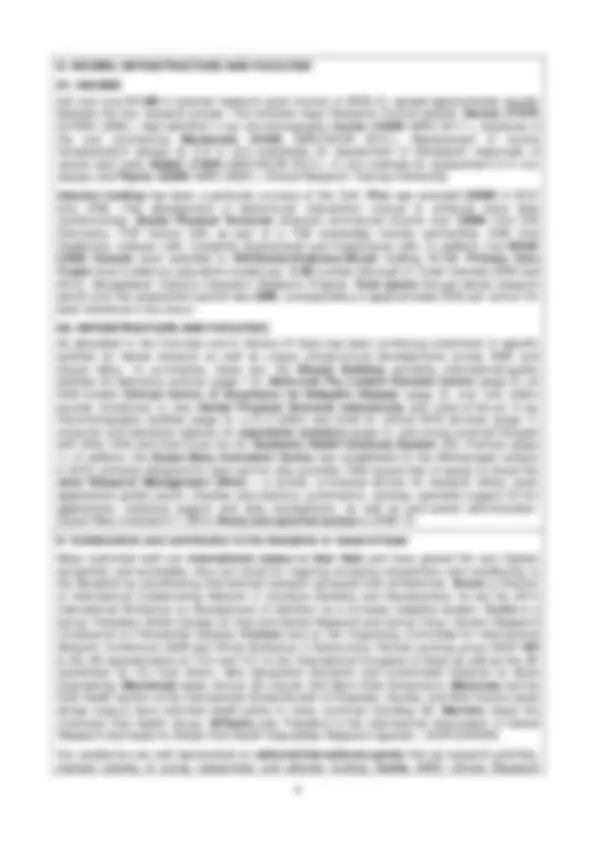
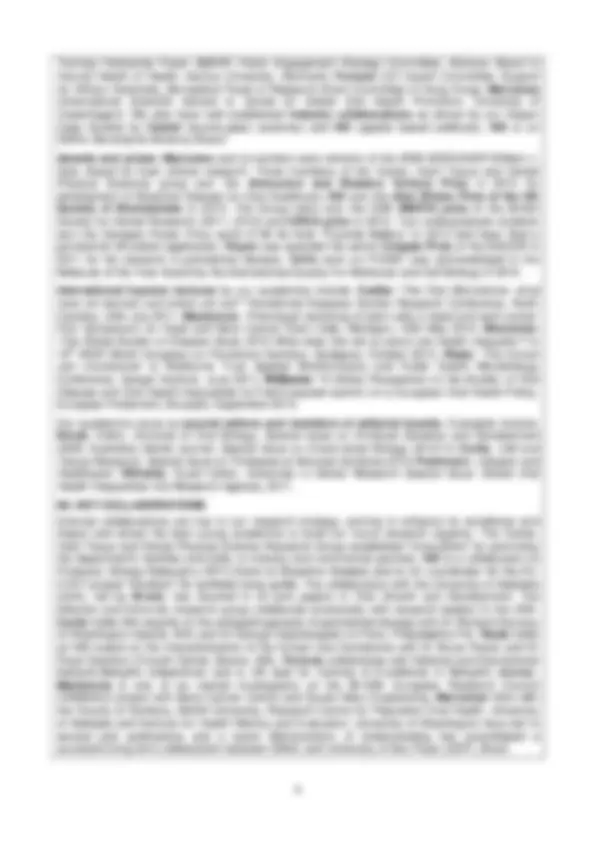


Study with the several resources on Docsity

Earn points by helping other students or get them with a premium plan


Prepare for your exams
Study with the several resources on Docsity

Earn points to download
Earn points by helping other students or get them with a premium plan
Community
Ask the community for help and clear up your study doubts
Discover the best universities in your country according to Docsity users
Free resources
Download our free guides on studying techniques, anxiety management strategies, and thesis advice from Docsity tutors
A. Overview. Queen Mary University of London (QMUL) is a research-led institution that provides an excellent environment for basic science and clinical ...
Typology: Study notes
1 / 9

This page cannot be seen from the preview
Don't miss anything!






Environment template (REF5) Institution: Queen Mary University of London
Unit of assessment: UoA3 Allied Health Professions, Dentistry, Nursing and Pharmacy
A. Overview
Queen Mary University of London (QMUL) is a research-led institution that provides an excellent environment for basic science and clinical research. This was reflected in the 2008 RAE which positioned Queen Mary 11 th^ overall and Dental research joint 1st^ in UK (75% of publication outputs scored as world leading or internationally excellent). Queen Mary was admitted to the Russell Group in 2012. Dental research is led by the Institute of Dentistry (IoD), one of six Institutes in the School of Medicine and Dentistry (SMD) and located on its expanding Whitechapel site.
Since 2008, we have built on our RAE 2008 success through the strategic goal of improved oral health as a component of (and a prerequisite for) good general health. IoD’s research is integrated in the wider research strategies and structures of SMD and Queen Mary: we link with research groups of significant critical mass in both SMD and the Faculty of Science and Engineering (S&E), where we take maximum advantage of facilities, expertise and intellectual environment. Of particular note for our interdisciplinary research are the outstanding facilities for basic science in SMD (described in our UoA1 submission), materials science in S&E (see our UoA 13B submission) and population health (see our UoA2 submission). Research at IoD thus sits within the mainstream of basic, clinical and population science at Queen Mary, drawing from it and contributing to it.
The creation of Barts Health, UK’s largest NHS Trust, in 2011 and a £1.2 billion redevelopment of the hospitals has had huge impact on SMD’s research activity and strategy. The final phase of the redevelopment in Whitechapel is the completion of our new Dental Hospital in early 2014 which will provide superb, state of the art clinical facilities for both research and education adjacent to the Blizard Building which remains an iconic research facility for cell and molecular research. In 2012 Queen Mary and Barts Health Trust became founding partners of our Academic Health Sciences System (UCL Partners) along with UCL, LSHTM and UCLH. We anticipate that the new ‘MED-City’ project on land between the hospital and medical school will support a world-leading Life Sciences and Clinical Research programme in medicine and dentistry during the next REF period.
The Institute of Dentistry undertakes basic science laboratory research, together with patient and population, and clinical biometric research. This brings together a range of multi-disciplinary teams with complementary skills in cell and molecular biology, microbiology, materials science, biophysics, clinical science and population health. A total of 35 staff (33.2 FTE) are returned in this submission under four separate research groups: Infection and Immunity (11 staff); Oral Cancer (7); Caries, Hard Tissues and Dental Physical Sciences (11); and Patient and Population Health (6).
B. RESEARCH STRATEGY
B1. STRATEGIC AIMS
We have sought to maintain our position as one of the UK’s top research-led institutions, following our success in RAE 2008. Through fundamental understanding of the cellular and molecular basis of oral disease, our strategy focuses on improving the diagnosis and treatment of disease, and on effective approaches to disease prevention and health promotion. In 2008- 13 our strategic aims have been to develop further our basic science research strengths, expand patient orientated clinical research and enhance the impact of our research. In these ways, the Institute of Dentistry is addressing the priorities of the RCUK, NIHR and NHS England and is aligned with the research strategies of Barts Health NHS Trust and QMUL. Key to this is our staffing strategy (see C1). We have continued to recruit new staff at all levels, and this return includes four new professorial appointments and seven new early career research (ECR) staff whom we are resourcing and supporting to make the transition to independent researcher.
The research culture of the Institute of Dentistry is enhanced by our policy of integrating research activity both intellectually and physically within the mainstream of research in SMD and Queen Mary. Thus, the laboratory based activities of the Oral Cancer and the Infection and Immunity Research Groups are accommodated in the Blizard Building in Whitechapel, adjacent to the clinical facilities of the Dental Hospital. The state of the art cell and molecular research
environment of the Blizard provides superb, technically-staffed core facilities for flow cytometry, imaging, tissue culture at defined oxygen tensions for optimal stem cell growth, and the full range of aerobic and anaerobic microbiology equipment. Cutting edge facilities for genomics are based in Barts and The London Genome Centre , the steering committee of which was chaired throughout the assessment period by the new Dean of Dentistry, Professor Mike Curtis. The Caries, Hard Tissue, and Dental Physical Sciences Research Group is located on the QMUL Mile End Campus alongside the School of Engineering and Materials Science and other collaborators in the School of Biological and Chemical Sciences. Major refurbishment of the Dental Physical Sciences laboratories was undertaken in 2010/11 along with purchase of new equipment including X-ray micro-tomography, a 19F NMR probe, dielectric thermal analyser and scanning electron microscope with digital mapping: a total investment in excess of £1million. The Centre for Oral Biometrics within Patient and Population Health is housed alongside the clinical facilities of the Dental Hospital in a modern multi-disciplinary facility for biological measurement relating to hard and soft tissue dental metrics, including laser scanning, 3D assessment and reconstructions.
Across all four research groups we have adopted a number of strategies to maintain excellence:
Attract high-performing research leaders in strategic priority themes. Hill was appointed in 2009 to build on our long tradition of research excellence in dental biophysics and the chemistry of apatites. This led to development of commercially available oral health care products based on novel glass formulations to promote enamel recalcification (see impact case study). Wade was recruited in 2013 for his leading role in characterisation of the oral microbiome and to complement the molecular microbiology expertise of Curtis. Other leading research professors recruited since 2008 include Alan Brooke , Cynthia Pine and David Williams. Allaker was promoted to personal Chair for his research in antimicrobials.
Recruit and develop the most able young researchers. For example, Payne was promoted to an academic post in 2013 following a successful MRC Clinical Research Training Fellowship including award of the Senior Colgate Prize (highest award of the British Society for Oral and Dental Research) for his work on dysbiosis of the oral microbiome in periodontal disease.
Secure substantial income , primarily from Research Councils but also diversify our income streams eg from charities, USA National Institutes of Health, DoH and Industry (see Section D).
Build external collaborations. Institute of Dentistry researchers have extensive collaborations with multiple research centres in the USA, Australia, Japan and EU (see Section E).
Publication in highest ranked non-specialist journals evidenced by outputs in this return in Nature Immunology, Cell Host & Microbe, Cancer Research and top specialist journals : J Clin Periodont, J Dent Res; Dent Mater; Caries Res.
Engage extensively with end users of our research including industry, policymakers and the public. Our industry links have produced new commercially available oral healthcare products ( Hill and Cattell ), evidence based contributions to determine international priorities for research, health policies and funding (Global Burden of Diseases 2010 study – Marcenes ) and internationally applied policy guidance on fluoridation ( Marinho ). Our public engagement and outreach strategy makes our research accessible to a wide audience (see Impact Template).
The research culture in the Institute of Dentistry is designed to achieve and celebrate excellence by emphasising researcher development and clear performance targets (see C1). All grant applications are internally peer-reviewed and bespoke support provided by experienced academics to ensure they reach a competitive standard prior to submission. In the next section we describe the work programmes of the four individual groups. While the four research groups encourage individual excellence and group focus, there is also strategic emphasis on productive collaborations within QMUL, nationally and internationally as illustrated below.
B2. RESEARCH GROUP ON ORAL CANCER The strategic aims of the group led by Mackenzie are to extend the knowledge base on behavioural and molecular aspects of head and neck cancers; to translate such information into diagnostic and therapeutic opportunities for patient benefit; and to develop functional interactions between laboratory research, population research, and clinical therapy. Collaborations with Barts Health NHS Trust in oral surgery (Hutchison) and oral pathology (Piper) provide additional expertise and materials that greatly strengthen the Oral Cancer Group. The main research themes
of the connection between oral inflammatory disease and pregnancy complications ( J Med Micro ); Payne (former MRC Clinical Research Training Fellow) who will continue to work with Curtis on the periodontal microbiome ( Cell Host & Microbe ); Seoudi (former ACL in oral microbiology) to work with Fortune on Behçet’s disease research ( Innate Immunity ); and Vartoukian (formerly a post- doctoral scientist with Wade) to extend her oral microbiome investigations ( IJSE, App & Env Micro ).
B4. RESEARCH GROUP ON CARIES, HARD TISSUE AND DENTAL PHYSICAL SCIENCES
In 2009 the previously separate Dental Biophysics and Dental Materials groups were merged with the recruitment of Hill as head. This development has resulted in a cohesive research programme focused on commercial opportunities and consumer benefits. The strategic aims of the group are to investigate the structure of teeth and bone and develop new materials and techniques with an emphasis on investigating caries, demineralization and remineralisation. There is a strong focus on outcomes in enhanced glass ionomer cements, calcium phosphate cements, bioactive glasses, and toothpastes. The strategic aims are to understand the fundamental processes involved in caries, demineralisation and remineralisation and the role of ions (Ca2+, Sr2+^ Zn2+, F-) present in saliva, toothpastes and released from restorative dental materials and to translate this into new dental materials and components for oral health care products. Hill ( Acta Biomater; Mater Chem ) and colleagues have developed new fluoride containing bioactive glasses for use in hypersensitivity and remineralising toothpaste. Karpukhina and Anderson ( Caries Res ) have collaborated in developing 19F Solid State NMR to study fluoride’s role in enamel demineralisation. Davis ( Caries Res; J Dent Res ) has designed and built a new X-ray Microtomography facility for the quantitative determination of mineral contents of dental hard tissues. Al-Jawad has developed Synchrotron X-ray diffraction techniques for studying caries, tooth mineralisation and diseases such as enamelogenesis imperfect ( Arch Oral Biol ). Boyde ( Eur Cells ; Mater ) and Rawlinson ( PLOS One ) have focussed on bone formation processes. Patel ( Dent Mater ) has developed techniques for drug delivery across the oral mucosa. Cattell ( J Dent Res ; Dent Mater ) has investigated new nano-reinforced leucite glass-ceramics Wong, Hill , Patel , and Karpukhina ( Dent Mater ) have developed new glass ionomer cements with a focus on improved materials.
The group have gained five CASE awards from GSK. They have a Licensing/Materials Transfer/ Consultancy Agreement with GSK to exploit the patented fluoride containing bioactive glasses. Perioproducts have launched UltraDEX Recalcify tooth paste and UltraDEX Oral Rinse, both based on nanohydroxyapatite developed by the group (see Impact Case Study). Cattell has successfully commercialised his dental porcelains (see Impact Case Study) and Hill and Patel have developed a new light cured glass ionomer cement with PSP Dental.
B5. RESEARCH GROUP ON PATIENT AND POPULATION HEALTH (PPH)
Established following our 2008 RAE success, the PPH research group represents a new strategic development for IoD. Led by Marcenes and enhanced by the recruitment in 201 1 of Williams for his global oral health expertise, its mission is to address inequalities in the burden of oral diseases at local, national, and global levels; identify oral health protective factors; and develop a cost- effective oral health promotion strategy. Specifically, the group has undertaken work to 1) explore the social, cultural, environmental and psychological determinants of oral health inequalities and link these to oral health outcomes via behavioural and biological pathways; 2) build the evidence base on effective interventions through evidence synthesis and methodology of systematic review, informing international priorities for research, policymaking and public/oral health funding; 3) undertake specific empirical studies in population oral research eg to document worldwide variation in timing of permanent tooth formation and thereby produce international standards to estimate age from dental records; 4) develop and evaluate preventive interventions, focusing especially on tobacco cessation in areas of socio-economic deprivation and ethnic diversity; 5) inform the methodology for oral health needs assessment in the UK and abroad, supporting data-driven service improvements and cost-effective interventions.
The East London Oral Health Inequalities (ELOHI) study led by Marcenes is an on-going mixed methods study that seeks to extend understanding of oral health inequalities using epidemiological surveys, interviews, focus groups and clinical examination. To date, it has identified a number of barriers, facilitators and pathways linking neighbourhood deprivation, oral health behaviours and
status. The East London Family study, evolved from ELOHI, is the leading two generation cross- sectional family study of oral health in the UK. It has elucidated the role of family functioning on determining oral health behaviour and status, and demonstrated that family has a protective effect against the detrimental effects of living in a socially deprived area. Marinho led multiple Cochrane systematic reviews on topical fluoride therapies for prevention of dental caries in children and adolescents, informing public health policy worldwide (see Impact Case Study). Liversidge led development of a comprehensive, widely used atlas to estimate age using tooth development (see Impact Case Study). PPH also leads a culturally tailored tobacco (smoking and chewing) cessation service, based on motivational interviewing, recruiting ~ 40 patients a month and achieving 62% abstinence rate at 4 weeks. The group has extensively researched local burden of oral diseases, emphasising the needs of our deprived and ethnically diverse population. The Oral Health Needs Assessment Unit is a centre of excellence in dental public health research led by Marcenes. In 2008 - 13 it produced 12 major oral health needs assessments with recommendations for local oral health strategy and a case study for a cost-effective oral health initiative to eliminate untreated decay. Pine has recently joined PPH to extend our strengths in relation to childhood caries. See Section E for details of world-leading activity in this area.
B6. FUTURE RESEARCH PLANS
As part of an overall strategy in SMD to focus primarily on major research themes characterised by significant infrastructure, world-leading research capacity and external collaborations, SMD plans a flagship initiative designed to strengthen and transform our research landscape in Life Sciences. It is anticipated that the expanded facilities for basic biomedical research, translational research and population analysis will bring direct benefits to both medical and dental research. Queen Mary is in the process of acquiring four acres of land in Whitechapel adjacent to the new Royal London Hospital to create a multi-disciplinary Life Sciences and Clinical Research Programme which will develop into a new Life Sciences Institute and translational research programme over the next REF period. We will develop our interdisciplinary links with colleagues in Science and Engineering to produce coordinated programmes that address the multi- level nature of oral health challenges from their genetic, molecular and cellular basis to their social determinants and the potential for community and population level interventions. Specific plans for dental research in the coming period are:
The Oral Cancer Group plans to maintain its strong basic and translational oral cancer research while strengthening interactions between basic and clinical sciences so as to enhance translational opportunities, especially via specific research studies spanning basic and clinical dentistry within the new Dental Hospital. We will maintain and expand our national and international collaborative research activities. Key Objectives are to: investigate and further define markers for cellular heterogeneity in oral cancer, particularly in relation to cancer stem cells and the process of EMT; determine how cellular heterogeneity drives tumour therapeutic survival and invasion/metastasis; produce in vitro cellular systems for the development of therapies that can overcome stem cell- associated therapeutic resistance; use senescence-associated metabolites for non-invasive detection of high risk pre-malignant lesions; and translate established genetic, epigenetic and gene expression signatures into clinical applications, including personalised medicine.
The Infection and Immunity Group plans to ensure sustained funding from MRC and NIH and industry. Specific aims are the use of mouse models, including gene knock-outs, to determine the influence of pathogens and host genetics on the development of periodontal disease and translate this work into human populations in the clinical facilities of the new Dental Hospital; apply high throughput next-generation DNA sequencing to provide a comprehensive analysis of the human oral microbiome in health and disease and establish the role of the unculturable component of organisms in these processes; collaborate further with industry to develop novel antimicrobials, specifically utilising nanotechnology approaches; capitalise on the enhanced clinical facilities to build translational research programmes particularly in relation to inflammatory conditions including Behçet’s and Sjogren’s, where large patient populations are treated locally.
The Caries, Hard Tissue and Dental Physical Sciences Group plan to investigate the fluorescence and properties of natural teeth, aiming to develop active whitening toothpastes as an alternative to peroxide bleaching. By studying the role of ions on tooth de- and re-mineralisation,
Trust Clinical Research Training Fellowship has recently been awarded to a new postdoc (Ryan) in the Infection and Immunity group. Queen Mary’s Fellowship Day provides postdocs with information from Wellcome, MRC and BHF on how to gain a fellowship. SMD runs learning sets for key fellowship calls, where applicants gain from mutual support and vicarious learning. Masterclasses and workshops. The annual SMD Winning Grant Funding masterclass is a valuable opportunity to learn directly from senior SMD academics about grant writing and the application process; it is attended by 50-75 post-docs. We also provide annual courses on how to lead and manage research teams, attended by 20-30 post-docs from across the Faculty. Career planning. Queen Mary runs a ‘Doctoral Transitions: Careers Beyond Academia’ to inform and educate about careers linked to research implementation and impact, especially the transition from academia into industry; alumni now based in industry return to give talks. Senior leadership programme. SMD nominates academic staff for a College wide ‘High Potential Leaders’ programme run by Queen Mary’s Centre for Academic and Professional Development. This comprises a residential workshop, coaching and action learning to support their development. Academic staff from the Institute of Dentistry have participated in this programme since 2011 including Patel in this submission. In addition, the Centre recently established a ‘Women into Leadership programme’ developed with Ashridge Business School to develop female academics to reader / professor level (see next point). Equality and diversity. To support every researcher to achieve their potential, we follow College equality and diversity policies. All staff must undertake equality and diversity training; regulations and handbooks are in place and regularly updated to address needs of staff with protected characteristics. The School of Medicine already holds an Athena SWAN bronze award and the IoD’s own application for a bronze award will be submitted in 2013. We offer flexible working and have a policy that all key meetings are held within core office hours. SMD has established an innovative and popular mentoring scheme for women academics.
C2. SUPPORT FOR POSTGRADUATE RESEARCH (PGR) STUDENTS
Queen Mary, and SMD in particular, is one of the UK’s most vibrant and stimulating settings for doctoral training. We offer an unparalleled environment for learning and personal development in interdisciplinary surroundings and with excellent NHS links. Of particular importance is the world- leading research community in London in general, which attracts the best students in Europe and gives them a vast range of post-doctoral options. The submitted groups for this UoA have a current total of 43 registered doctoral students.
In 2012 Queen Mary established a Doctoral College to support both PGR students and postdoctoral researchers. Strategically led by a Doctoral College Management Group (headed by the Vice Principal for Research and with senior cross-Faculty representation), its activities are delivered and coordinated by two dedicated Researcher Development Officers (in the Centre for Academic and Professional Development) and a Careers Adviser for Researchers (QM Careers). These staff work in partnership with each Faculty to ensure that researcher development activities align to specific needs. Queen Mary uses a points-based RGR training system based on the RCUK endorsed Vitae Researcher Development Framework. This allows disciplinary flexibility, ensuring that all students receive career-appropriate transferable skills and research training. The Doctoral College also runs PhD induction for all PGR students, who are also encouraged to attend annual Interdisciplinary Cohort Training (courses include Maximising the Impact of Conferences and Networking; and Understanding the Impact of your Research).
This combination of strong central governance, rigorous adherence to national training standards and a flexible and responsive approach to supporting Faculties enables all SMD institutes to provide a personalised and discipline-specific programme of PGR support while also making maximum use of the many and varied high-quality opportunities for PGR student development and interdisciplinary interaction provided by our central services. All doctoral students have two supervisors (one of whom must have a significant record of success); supervisors must undergo training, updated 3-yearly. Students have formal milestones with assessed submissions at 9 and 18 months and mock PhD vivas. The IoD is collegial in ethos , with formal and informal mentoring of early academics by more senior ones in close-knit subject families. PGR students are strongly encouraged to present at conferences and participate in local and national competitions.
IoD won over £7.5M in external research grant income in 2008 - 13, spread approximately equally between the four research groups. This includes major Research Council awards: Davies: £797K (EPSRC 2008 - ), High definition x-ray microtomography ; Curtis: £445K (MRC 2011-), Dysbiosis of the oral microbiome ; Mackenzie: £344K (MRC/NC3R 2012 - ), Replacement of murine transplantation assays by 3-D in vitro substitutes for assessment of therapeutic responses of cancer stem cells ; Biddle : £195K (MRC/NC3R 2012 - ), In vitro methods for replacement of in vivo assays ; and Payne: £225K (MRC 2009 - ): Clinical Research Training Fellowship.
Industry funding has been a particular success of this UoA. Pine was awarded £550K in 2012 from GSK ( The development of behavioural intervention manual to enhance twice daily toothbrushing). Dental Physical Sciences attracted commercial income over £300k from Hilti (Germany), PSP Dental (UK) as part of a TSB knowledge transfer partnership, GSK Oral Healthcare, Unilever (UK), Credentis (Switzerland) and Periproducts (UK). In addition, five RCUK CASE Awards were awarded to Hill / Davies / Anderson / Brook totalling £0.5M. Primary Care Trusts have funded our population studies eg : £1M (London Borough of Tower Hamlets 2009 and 2012 ), Bangladeshi Tobacco Cessation Research Projects. Total spend through dental research grants over the assessment period was £8M, corresponding to approximately £50k per annum for each individual in this return.
D2. INFRASTRUCTURE AND FACILITIES
As described in the Overview and in Section B there has been continuing investment in specific facilities for dental research as well as unique infrastructural developments across SMD and Queen Mary. To summarise, these are: the Blizard Building providing international-quality facilities for laboratory science (page 1-2); Barts and The London Genome Centre (page 2); an NHS-funded Clinical Centre of Excellence for Behçet’s Disease (page 3); over one million pounds investment in new Dental Physical Sciences laboratories and state-of-the-art X-ray microtomography facilities (page 4); a £1.2 billion new build for clinical NHS services (page 1); computer and statistical capacity for population analytics (page 4); and strong external linkages with other HEIs and local trusts via our Academic Health Sciences System UCL Partners (page 1). In addition, the Queen Mary Innovation Centre was established on the Whitechapel campus in 2010, primarily designed for start-ups but also provides 7000 square feet of space to house the Joint Research Management Office – a central, co-located service for research ethics, grant applications (public sector, charities and industry), governance, costings, specialist support for EU applications, statistical support and data management, as well as post-award administration. Queen Mary invested £11.2M in library and ejournal access in 2008-13.
E. Collaboration and contribution to the discipline or research base
Many submitted staff are international names in their field and have gained the very highest recognition and accolades; they are noted for inspiring emerging researchers and contributing to the discipline by coordinating international research symposia and conferences. Brook is Director of International Collaborating Network in Orofacial Genetics and Development ; he led the 2012 International Workshop on Development of Dentition as a Complex Adaptive System. Curtis is a former President, British Society for Oral and Dental Research and former Chair, Gordon Research Conference on Periodontal Disease. Fortune was on the Organising Committee for International Behçet’s Conference 2009 and World Workshop V-Submucous Fibrosis working group 2009. Hill is the UK representative on TC4 and TC7 of the International Congress of Glass as well as the UK coordinator for EU Cost Action: New Generation Biometric and Customised Implants for Bone Engineering. Mackenzie leads Annual UK Cancer Cell Stem Cells Symposium. Marcenes led the Oral Health section of the international Global Burden of Diseases, Injuries, and Risk Factors study whose outputs have informed health policy in many countries including UK. Marinho chairs the Cochrane Oral Health Group. Williams was President of the International Association of Dental Research and leads its Global Oral Health Inequalities Research Agenda – IADR-GOHIRA.
Our academics are well represented on national/international panels that set research priorities, oversee training of young researchers and allocate funding: Curtis ( MRC Clinical Research